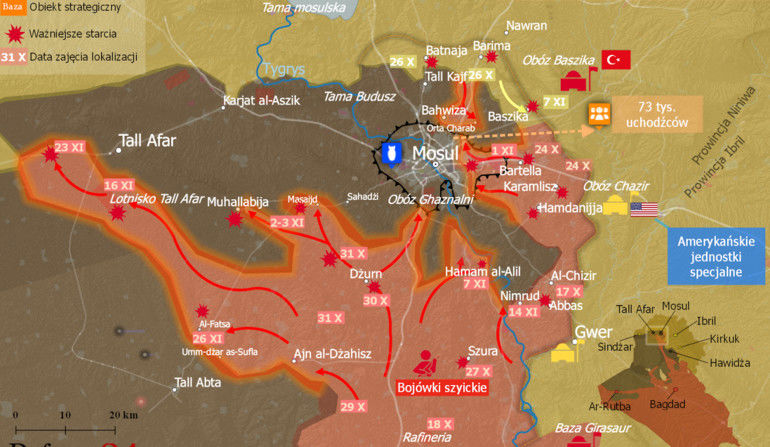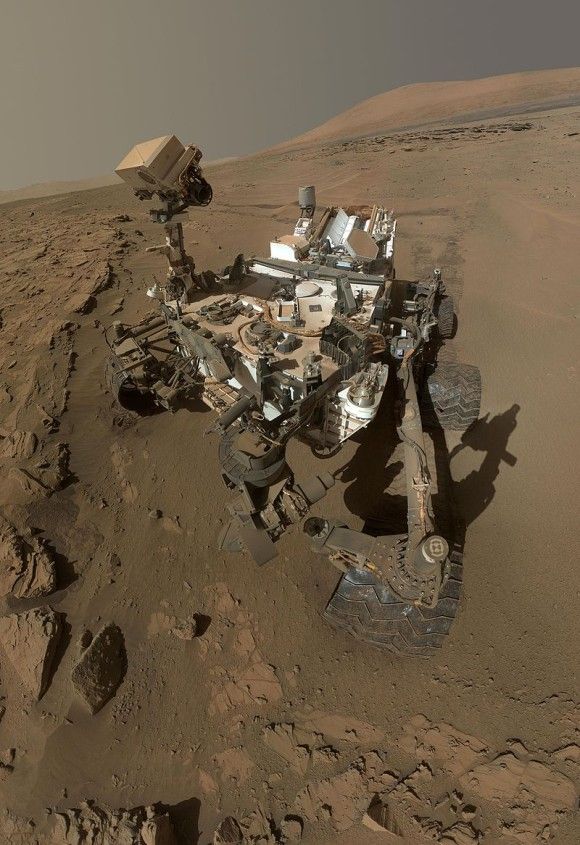Armed Forces
Mosul Offensive: Clearing the Desert and Attacking the Southern City Limits [Frontline Report]
On 26th November, the Iraqi Parliament considered Hashed Shaabi to be a part of the regular army. Meanwhile, units belonging to that formation, besides the Tall Afar operation, also continue to sweep the south-western Nineveh area, clearing it from the Daesh elements which maintain their presence there. At the Western bank of the Tigris river, an operation is being carried out north of Hamam al-Alil, with involvement seen on the part of the Sunni Hashed Shaabi units formed there – as Witold Repetowicz reports.
Tall Afar
The decision undertaken by the Iraqi Parliament means that no obstacles exist that could potentially make it impossible for Hashed Shaabi to start an operation, the goal of which would be to free the city of Tall Afar. Before that happened, Prime Minister Abadi declared that solely regular units of the Army would be permitted to take part in the operation to come. It shall be expected then that Hashed Shaabi is going to begin another, final stage of the operation in Tall Afar, in the upcoming time. Nonetheless, some commanders stationed in this region suggest that this could happen as late as in two-three weeks. A lot of that depends on the effectiveness, with which the area controlled by Hashed Shaabi is being expanded, south of Tall Afar and Mosul (fifth phase of the operation).

Clearing the Desert
Blitzkrieg undertaken by the Shiite Muslim Militias led to a situation, in which the head of the offensive made progress, 100 km away from al-Ghayara, reaching the Tall Afar airport. However, at some locations, the strip of the conquered terrain is only couple to several kilometres wide. This is not a critically small area, despite the fact that the said area is not densely populated, and excluding two mountain ranges between Tall Afar and Mosul, it is quite plain. However, one should remember that a few months ago, as a result of a sudden strike, Daesh has been able to recover the desert town of Ar-Rutbah in Al Anbar. Thus, Hashed Shaabi is trying hard to cover its positions and lines in the back, in preparation for the decisive battle. The units are also willing to cover the western flank of the forces that would be attacking Mosul from the south, along the Tigris river.
So called fifth phase of the operation assumes that the villages scattered within this semi-arid area, from one side to the north, towards the Tall Afar – Mosul road, entering the area between the aforesaid mountain ranges in the al-Muhallabija region at one side, and to the south-west, i.e. deeper into the desert, are being gradually swept and cleared. Within this area, Hashed Shaabi is said to have around 1000 soldiers deployed, divided into five groups. One of the said groups, Live Ali Akbar, is operating and advancing towards the town of Tall Abtah. On 26th November, another two villages were freed – Um-Jar Al-Suflah and Al-Fatsah. As I was informed by the commander of the operation, Ali Hamdani, the attack began at dawn, in the early morning Um-Jar Al-Suflah was conquered, with Al-Fatsah to follow, after the midday prayer. The terrorists did not create any resistance within those villages, which had been also left by the inhabitants. A day before that, the terrorists were defending their positions there, however during the night they withdrew their units further south. During the day, three VBIED incidents took place, however, all three vehicles were successfully neutralized, before they reached their targets (with the use of Kornet ATGMs, RPGs or tanks). Besides VBIED, the main problem at the current stage is posed by the IEDs, left around the freed villages. Clearing al-Fatsah and removing the IEDs took four hours, more IEDs were discovered later, buried in the ground. Moreover, every day, each of the groups involved in the offensive, clears, on average, around 7 kilometres of roads, looking for the IED threat.
Immediately after the villages were taken over, armoured diggers were deployed there, in order to create fortifications (ditches and berms), along which BTR armoured vehicles and tanks were placed, in order to open fire at the Daesh positions in the neighbouring village of al-Miryahal, around 4 kilometres away. This location is the target for the operational activities undertaken on the next day. For reconnaissance purposes, Hashed Shaabi forces utilize drones, sent over the villages taken by Daesh. Usually, no more than couple to several terrorists are present at such points of resistance. However, not every location enables them to withdraw their forces on time. During another operation which took place within that region on the same day, carried out by the Furqan al Abbas group, several Daesh terrorists were imprisoned (they were not killed, as they were arrested and detained by the Police).
Attack Against Southern Mosul, Started in Haman al-Alil
Hamam al-Alil is an important, relatively small town located around 20 kilometres south of Mosul. The significance of that location results from the fact that it is the last of the larger urban areas one encounters before reaching Mosul, located at the western bank of the Tigris river, the same side where the city centre and the airport are also placed. Secondly, it is the place where Kathan Ibrahim al-Jaburi resides, who is the leader of the Jaburi-Wawi tribe, in the Mosul area. Jaburi is one of the most important Iraqi Arab tribes, including the leader of the Iraqi parliament, Salem al Jaburi, governor of the Salahaddin Raed al-Jbouri district, and numerous Sunni, highly ranked commanders of the Iraqi army. The said tribe also has several Shiite branches, which influences its pro-governmental politics. Jaburi rejects the idea of federalization of Iraq, and the concept of creating so called “Sunniland”. The former governor of the province, Athila al-Nudjayfi, is considered to be a traitor and the main cause for fall of Mosul, which took place two years ago. Kahtan, following the taking over of the Hamam al-Alil by Daesh, found shelter in Erbil, and then in Makhmour, where he started to create the Jaburi tribe armed units. Currently, they include 500 persons, and are being constantly expanded and, constitute a part of the Sunni Hashed Shaabi. In total, the Sunni units taking part in the Mosul operation, involve several thousand persons.
Hamam al-Alil was freed on 7th November. Before this happened, Daesh carried out mass executions of several hundred members of the Jabouri tribe, suspected of being loyal towards the sheik and towards the Iraqi government. The operation, the goal of which was to retake the city, also involved several Sunni tribe units of the Hashed Shaabi element.
The Shiite militias do not remain actively operational here, however, the special units of the Federal Police are involved in the activities in this area, along with the Army and the aforesaid tribe units. The above mentioned forces have already reached the southern limits of the Mosul airport, however, they have not been successful when it comes to yielding the complete control over the area located between Mosul and Hamam al-Alil (the frontline is located around 5 kilometres north of that city). Moreover, Daesh is still controlling the area on the other side of the river, at the Hamam al-Alil line. Thus, it does not seem likely that the Iraqis enter Mosul on the western side of the Tigris river. Most probably, this will happen only after Tall Afar is taken over, and when the area between Tall Afar and Mosul is cleared, by the Shia Hashed Shaabi units. Shiite components of the Hashed Shaabi forces will not enter the city itself though.
Hamam al-Alil almost has not been destroyed by the warfare, as Daesh only damaged the power and water infrastructure, and despite the closeness of the frontline, life goes on normally in the city in question. Safety is ensured by the Federal Police and by the Jabouri tribe. A similar situation can be witnessed almost within the whole area located south of the frontline, west of the Euphrates. Here, no incidents are taking place between the local Sunni people and the Shiite militia. More damage can be witnessed along the main highway, south of Mosul (through Tikrit, towards Baghdad). Moreover, Daesh also lit up the oil drilling sites in Ghayar and Hamam al-Alil, which have been on fire for several weeks now.
Witold Repetowicz


